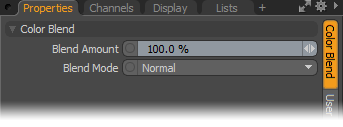
The Color Blend node combines two different inputs together, resulting in a single evaluated output. A third input masks the operation, allowing its input value to drive the blending amount. The Color Blend attributes also allow you to choose the type and amount of blending to perform, adding additional flexibility to the blend operation.
The Color Blend node is added to the Schematic Viewport using the Add function, found in the pop-up menu under Channel Modifiers > Color > Color Blend. Once added, the RGB color (or Value) outputs of other nodes can be connected to the A or B inputs. Additionally, a single channel Mask Value can be specified to control the blending between the two values texturally or per sample, based on the input (this is essentially like controlling the Blend Amount with the mask values). The result of the blend evaluations are then sent through the Color output for connecting to another RGB or value input.
NOTE: For information on working with node graphs, see Schematic Viewport
When the node is selected, attributes appear in the Properties panel.

Color Blend
|
Option |
Description |
|---|---|
|
Blend Amount |
The Blend Amount essentially changes the opacity of the A input value, where 100 is fully the A input, 50% is equal parts A and B, and 0% is fully the B input value. |
|
Blend Mode |
The Blend Mode options determine an additional way to calculate the way the A and B values combine into the final result, defined by various mathematical functions that are applied to the numerical values of each input. NOTE: For more information on Blend Modes, see Layer Blend Modes |

Schematic Node: Color Blend
|
Option |
Description |
|---|---|
|
Color A/B Input |
These inputs read RBG values from the output of another node. Input values can be simple RGB values or complex combinations of multiple nodes. The final representation for the blending between the two inputs is determined by the Blend Amount, the Blend Mode, and the Mask Input. |
|
Mask Input |
The Mask Input controls the transparency of the A input value, revealing the B values in the masked areas. White shows the A input fully, attenuating toward black which shows the B input value. |
|
Color Output |
The Color output field represents the final results of the evaluated blend. |